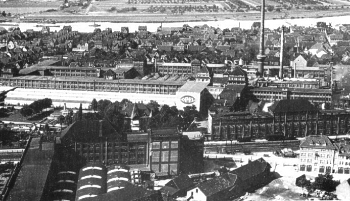
.
. .
..
. . . .
Project Yellowstone Plants Other Opel Plants The new Rüsselsheim plant has a planned annual capacity of around 270,000 cars, manufactured on a joint production line in three shifts. The facility, which is being built along the lines of the Opel production plant in Eisenach, is one of the biggest projects in the company's DM 9 billion investment program in Germany.
© 1999-2005
Copyright |
Opel : Ruesselsheim Plant, Germany
The Ruesselsheim Opel plant in 1920 source : Adam Opel AG The age of automobile production began at Opel in 1899 with the legendary "Lutzmann patent motor car". During the subsequent period, the car manufacturer enhanced its popularity with a number of new attractive models and its exciting involvement in motor sports.
In 1924 in Rüsselsheim, Opel became the first car manufacturer in Germany to install an assembly line. At the same time, the company updated its entire machinery and imported the very latest tooling machines from the USA. It all involved an enormous capital expenditure of one million gold marks. The first car to come off the production line was another history-maker: a new 4/12 hp model that was popularly called the "Laubfrosch" (or Tree-frog) because of its characteristic green paintwork. By 1926, all the production areas were linked to the production line and by 1927, a "Tree-frog" was coming off the line every 4.5 minutes.
The next milestone was the year 1935 when Opel presented the first series-produced car with a self-supporting all-steel body. It was accompanied by such design benefits as lower vehicle weight, more sprightly driving performance from an equally sized engine, lower consumption and greater safety. It also featured a very important innovation from the manufacturing point of view, and one which was destined to gradually find its way into car production generally: the so-called "marriage" of the body and the engine. The pre-assembled axles and engines were no longer lifted into the bodiless chassis, but were raised up to the shell from below. Opel constructed lifting tables specifically for this purpose.
The post-war rebuilding of Opel's Rüsselsheim production plants was completed in 1950. Up until 1954, the company invested a total of DM 300 million - a huge sum at the time. Innovative electronic, pneumatic and precision engineering devices and testing instruments allowed the company to keep to what, for those days, were very narrow production tolerances. The installation of a new transfer machine line brought a further increase in capacity so that, with more than 167,000 units built in December 1954, Opel managed to achieve a growth in production of around 60 percent within a single year. In May 1954, Opel began what at that time was the biggest new industrial construction project in the Federal Republic of Germany when it laid the foundation stone for the new K40 body plant. The new buildings accommodated not only the stamping shop but also the final assembly. The production lines, which were a total of 28 kilometers long, were started up on August 13, 1956, and production got under way on a total working area of 286,000 square meters. This raised the production capacity to around 1000 vehicles per day. A further innovative leap came with the opening of the brand new paint shop in 1981. It measured a gigantic 400 meters in length, 80 meters in width and 32 meters in height, and stamped a new mark on the plant. The true innovation, however, was inside the hall. Opel was the first car manufacturer in the world to use environmentally compatible water-based coatings in series production, initially in the primer, but later also in the other coats. Apart from this, electronic systems were used to control the entire process and monitor the quality. Robots replaced people wherever health risks could not be ruled out. In addition to the large-scale arrival of robots, another new trend became reality in the Rüsselsheim production facility at the end of the eighties: With its modular production system, Opel introduced the first aspects of group work. The employees put together sub-assemblies such as doors in so-called "assembly islands", away from the actual production line. The work became far more interesting than on the production line, because manual operations that were previously carried out in isolation were now performed in teamwork. Rüsselsheim thus pioneered an innovative working method which took a few more years to become fully adopted in car production generally - for example with the opening of Opel's plant in Eisenach.
|
|



